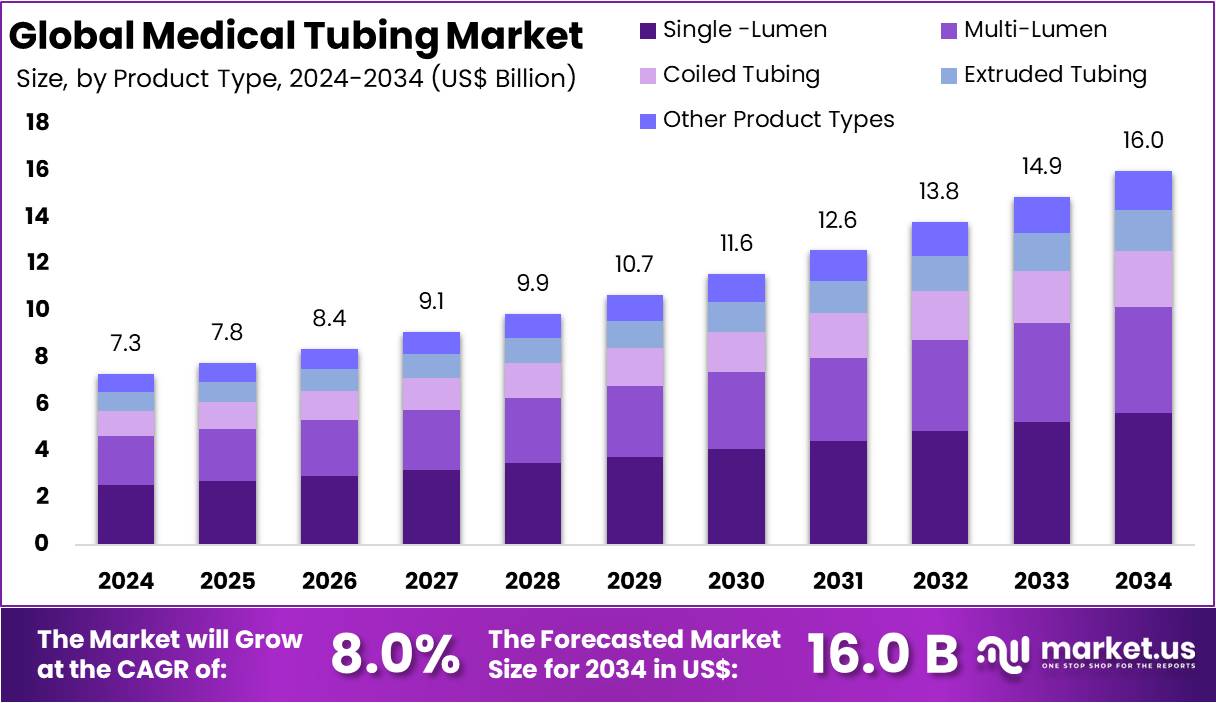The global medical tubing market is projected to reach around USD 16 billion by 2034, up from USD 7.3 billion in 2024. This reflects a steady CAGR of 8% during the forecast period from 2025 to 2034. North America leads the market with a 39.5% share, valued at USD 2.9 billion. The steady rise in hospital admissions and surgical procedures is a major driver of this market. Chronic diseases are another major factor boosting demand for medical tubing. Conditions like diabetes, cardiovascular disorders, and kidney failure require continuous care. According to the CDC, 6 in 10 adults in the U.S. have at least one chronic disease, and 4 in 10 suffer from two or more. Medical tubing is used for insulin infusion, cardiac catheterization, and dialysis, making it vital for long-term treatments. The need for tubing that offers long-lasting performance and safety is therefore increasing rapidly.
Infection prevention has become a top concern in healthcare settings. Since the COVID-19 pandemic, hospitals have prioritized hygienic and sterilizable equipment. Tubing materials that resist bacterial growth are now in high demand. WHO continues to stress the importance of infection control in hospitals. This has led to upgrades in medical tools to meet higher safety standards. Alongside this, new materials like silicone and thermoplastic elastomers are being used due to their flexibility, strength, and safety. Regulatory support from agencies like the U.S. FDA is encouraging innovation, helping manufacturers develop advanced tubing systems that meet global medical needs.

Key Takeaways
- According to recent figures, the global medical tubing market was valued at USD 7.3 billion in 2024 and is set to reach USD 16.0 billion by 2034.
- An industry expert noted that the market is expected to grow steadily at a CAGR of 8.0% over the next ten years.
- In 2024, single-lumen tubing dominated the product segment, accounting for 35.8% of the global revenue share due to its wide application.
- Analysts observed that polyvinyl chloride (PVC) led all material types, contributing 31.0% to the total market revenue in 2024.
- The bulk disposable tubing category stood out, capturing a 34.3% share of the global medical tubing market, as reported by researchers.
- Offline distribution channels remained dominant, generating 64.1% of total sales across the global market during 2024, according to market watchers.
- North America retained its leadership in the global medical tubing market, securing more than 39.5% of the revenue share in 2024.
GET SAMPLE REPORT : https://market.us/report/medical-tubing-market/request-sample/
Emerging Trends
1. Growing Demand for Minimally Invasive Surgeries
Minimally invasive surgeries are becoming more common in hospitals and clinics. These procedures use thin and flexible tools that enter the body through small cuts. To support this, there is a high demand for strong and precise medical tubing. Patients prefer these surgeries because they offer faster healing, less pain, and fewer complications. Medical tubing plays a key role in guiding instruments inside the body. As this trend grows, the need for high-quality tubing continues to rise, especially in heart, vascular, and orthopedic surgeries.
2. Rising Use of Biocompatible and Eco-Friendly Materials
There is a clear shift toward materials that are safe for use inside the body. Biocompatible tubing prevents negative reactions in patients and supports better healing. At the same time, manufacturers are focusing on eco-friendly materials. These reduce medical waste and support sustainability goals. Popular choices include silicone, thermoplastic elastomers (TPE), and recyclable plastics. This trend reflects both patient safety and environmental responsibility. More hospitals are now choosing tubing that meets both medical and green standards.
3. Integration of Smart Technologies
Smart medical tubing is becoming a game-changer in healthcare. These tubes are designed with built-in sensors or electronic components. They can monitor key factors like temperature, fluid flow, and internal pressure in real time. This is especially useful in intensive care units and home-based medical devices. The data collected helps doctors make faster, more accurate decisions. As wearable devices and remote monitoring gain popularity, smart tubing is expected to become even more important in patient care.
4. Customization Based on Medical Devices
Medical tubing is no longer one-size-fits-all. With advanced medical devices on the rise, tubing must now meet very specific needs. For example, tubing for insulin pumps must be highly precise. Dialysis machines need strong, chemical-resistant tubes. Feeding tubes may need UV protection. Manufacturers now design tubing to match the function of each device. Customization improves device performance and patient comfort. This trend is driven by growing use of personalized treatment and specialized equipment.
5. Rapid Growth in Home Healthcare
More patients, especially the elderly, are receiving treatment at home. This shift is boosting the demand for safe and easy-to-use medical tubing. Common uses include oxygen therapy, infusion pumps, and wound drainage systems. Home-use tubing must be durable, lightweight, and easy to handle. It also needs to meet safety standards for hygiene and comfort. As home healthcare grows, manufacturers are focusing more on creating user-friendly tubing for personal medical devices.
Conclusion
In conclusion, the medical tubing market is showing strong and steady growth due to rising healthcare needs across the world. With more surgeries, chronic illnesses, and home-based treatments, the use of safe and flexible tubing is becoming essential. Hospitals are now looking for tubing that supports infection control and works well with modern medical tools. Materials like silicone and thermoplastic elastomers are gaining attention for their safety and durability. The rise in personalized care and smart technologies is also shaping how tubing is made. As healthcare systems aim for better outcomes and patient comfort, the demand for high-quality, customizable tubing will continue to grow in the coming years.



